SteelPad is a jumbo-sized
metal mousepad from Denmark aimed particularly to satisfy serious
gamers' increasing demands for optimal accuracy. The company pledges,
"We want to become the pro gamer's preferred mousepad. We strive hard
to keep up with the pro gamer's increasing demands for optimal
accuracy."
Incidentally, SteelPad mousepads were developed in consultation
with the Schroet Kommando Gaming
Clan and are touted as being especially well suited to gaming
applications.
Despite its name, SteelPad is actually made from 3.5 mm aluminum
plate with a proprietary hardened surface coating engineered to
optimize both performance and traction. SteelPad is claimed to provide
optimal performance with both conventional ball mice and optical mice -
or at least some optical mice. Soft Trading warns that SteelPad doesn't
work with Logitech Optical mice other than the MX Series, and I found
that the LapWorks
Optical Scroll Mini Mouse did not like the SteelPad either.
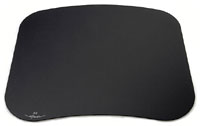 The SteelPad mousepad comes in two sizes. Our test unit was
the larger 4S model, which measures 290 x 267 mm (about 10-1/8" x
11-3/8"). The standard 3S SteelPad has smaller dimensions of 250 mm x
235 mm.
The SteelPad mousepad comes in two sizes. Our test unit was
the larger 4S model, which measures 290 x 267 mm (about 10-1/8" x
11-3/8"). The standard 3S SteelPad has smaller dimensions of 250 mm x
235 mm.
I'm not a gamer, but I do use Quill
and Contour Perfit large mice, which
are two of the physically largest mice available for the Mac platform.
These mice are great - very comfortable for those of us who struggle
with mousing pain, but they do tend to be a bit cramped for space on a
standard mousepad. I was curious to see how they would fare on a
larger expanses of the SteelPad mousepad.
A recommended accessory for use with SteelPad 4S is SteelPad
PadSurfer - a self-adhesive Teflon® tape appliqué for the
mouse "feet" (or contact surfaces) developed especially for the
SteelPad surface. A strip of the PadSurfer material comes with the
SteelPad, so the first order of business was to apply it to a mouse.
This turned out to be a moderately tedious job. You have to measure the
mouse feet and then cut the Teflon film to match their shape as closely
as possible (a bit of overlap is recommended). It took me nearly an
hour to do two mice (seven "feet" in total). Someone with nimbler
fingers might be able to do it more quickly.
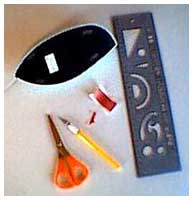 Tools I used included a ruler, an X-Acto knife, and a
pair of scissors. Aside from getting the shape of the cut out material
accurately matched, the trickiest part of the job was separating the
sticky Teflon film from its backing and then transferring it to the
mouse feet without it sticking to itself or my fingers. Also, don't
forget to wash any dirt or oily residue from the mouse feet before
applying the Teflon film.
Tools I used included a ruler, an X-Acto knife, and a
pair of scissors. Aside from getting the shape of the cut out material
accurately matched, the trickiest part of the job was separating the
sticky Teflon film from its backing and then transferring it to the
mouse feet without it sticking to itself or my fingers. Also, don't
forget to wash any dirt or oily residue from the mouse feet before
applying the Teflon film.
Soft Trading recommends that when applying the Teflon tape you make
the pieces bigger than the feet and make sure that the tape is glued
all over the feet - right down to the mouse bottom surface - to ensure
that no edges can pick up dirt. Seal the edges with your
fingernail.
That preliminary task accomplished, I proceeded to check out the
SteelPad, which is, as noted above, a flat metal slab with a black
satin "stealth" finish. On the bottom side are eight rubbery urethane
"feet," which seemed to have plenty of traction and do a good job of
keeping the SteelPad from skating around the your desk or table.
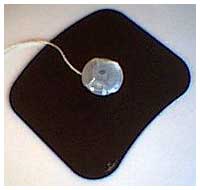 I found that the mouse slid
effortlessly about on the SteelPad's surface with its Teflon coated
feet, but then so did an Apple
"hockey puck" USB ball mouse I tried for comparison, and it had no
Teflon film applied.
I found that the mouse slid
effortlessly about on the SteelPad's surface with its Teflon coated
feet, but then so did an Apple
"hockey puck" USB ball mouse I tried for comparison, and it had no
Teflon film applied.
The downside was the "metallic" sound either type of mouse makes as
it slides across the SteelPad's metal surface. Perhaps you would get
used to this, but I found it irritating.
Another characteristic of metal surfaces is that they tend to feel
cold under normal circumstances, although I also found that the black
SteelPad would get very hot when exposed to direct sunlight. That would
not likely be a very common issue, however.
I have to say that I prefer the aural and tactile characteristics of
plastic or fabric-coated mousepads.
So how did the SteelPad perform as a mousing platform? Well, with
the ball mouse it worked great. This is probably an ideal surface for
ball mice - flat, smooth, excellent traction, and easy to clean.
Unfortunately, I didn't fare as well with the optical mice. I
established for myself that the Logitech Cordless Mouseman wireless
optical mouse wouldn't work at all with the SteelPad, nor would the
LapWorks Mini Mouse. The cursor simply refused to respond.
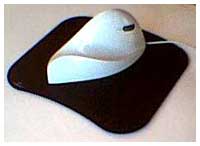 The Quill mouse's performance was better, but
erratic, with the main problem being a reluctance to start tracking
from rest. Once you got the cursor moving, it tracked nicely and with
satisfactory accuracy, but about half the time (or more) the cursor
would get "stuck" and refused to respond until I applied some very
vigorous body-English, moving the mouse back and forth on the pad
rapidly.
The Quill mouse's performance was better, but
erratic, with the main problem being a reluctance to start tracking
from rest. Once you got the cursor moving, it tracked nicely and with
satisfactory accuracy, but about half the time (or more) the cursor
would get "stuck" and refused to respond until I applied some very
vigorous body-English, moving the mouse back and forth on the pad
rapidly.
However, I've noticed that the Quill mouse is a bit picky about the
sort of surface it's used on, and it has issues with some conventional
mousepads as well, especially ones imprinted with text or graphics and
uneven coloring. On the other hand, it works great with the black
plastic SteelPad 4D mousepad reviewed below.
I am obliged to say that I was not blown away by the SteelPad as a
mousing platform for the sort of computering I do. On the plus side,
it's very nicely finished and attractive in a subdued and tasteful way.
The materials and workmanship appear to be first-rate. The large
mousing area would be a major advantage with my big Quill mice (I have
both right- and left-handed versions) if it were not for the
cursor-sticking problem, but that is a big "if" that renders those mice
essentially unusable with this pad.
I can't speak to the SteelPad's advantages or otherwise for gaming -
its primary target market - since I have no games on my computer other
than a couple of chess applications, which I don't think is quite what
they have in mind. However, for ball mice, it is, as I noted, a
functionally superb mousing surface.
The SteelPad 4S has a price tag of: DKK 299, €39.95, US$49.95
+ shipping, which is a hefty chunk of change for a mousepad. However,
if it will give you the performance edge you're looking for in
competitive gaming, perhaps the cost is justifiable in that
context.
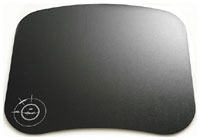 Happily, the SteelPad folks have addressed
my issues with the SteelPad 4S by releasing a similarly large (11" x
10" or 290 x 267 mm) mousepad styled identically to the for 4S model,
but this time made from plastic - the SteelPad 4D. Unlike the 4S, after
using it for several months, I can affirm unreservedly that the
SteelPad 4D is the best mousepad I've ever used.
Happily, the SteelPad folks have addressed
my issues with the SteelPad 4S by releasing a similarly large (11" x
10" or 290 x 267 mm) mousepad styled identically to the for 4S model,
but this time made from plastic - the SteelPad 4D. Unlike the 4S, after
using it for several months, I can affirm unreservedly that the
SteelPad 4D is the best mousepad I've ever used.
Aside from the new (and quieter) material, the SteelPad 4D is also
double-sided, with one mousing surface smooth and the other
rough-textured, which may work better with in certain mice. The
SteelPad 4D also comes with a more heavily textured soft underpad made
out of a "stickier" plastic material that cushions the mousing surface
and provides traction to keep the SteelPad from skating around on the
desk or table surface.
Soft Trading says that the plastic SteelPad 4D is compatible with
all mice, and I've found that it works fine with the several I tried -
both conventional ball and optical units, including the Quill mouse.
The mousing surface is very slick and fast, offering minimal resistance
to tracking motion, especially if you employ the "PadSurfer" Teflon
mouse foot appliqué material to your mouse. The 4D resists
getting dirty and is easy to clean when it does.
I really like the plastic SteelPad 4D, which, in summary, has
eliminated the complaints I had about the 4S while essentially
retaining its virtues, as well as costing only half as much.
SteelPad 4D sells for DKK 149, €19.95, US$24.95 plus
shipping
C/O Soft Trading
Ryesgade 19C
DK-2200 Copenhagen
Denmark
Phone: +45 7025 0075
Fax: +45 7025 0076

 The SteelPad mousepad comes in two sizes. Our test unit was
the larger 4S model, which measures 290 x 267 mm (about 10-1/8" x
11-3/8"). The standard 3S SteelPad has smaller dimensions of 250 mm x
235 mm.
The SteelPad mousepad comes in two sizes. Our test unit was
the larger 4S model, which measures 290 x 267 mm (about 10-1/8" x
11-3/8"). The standard 3S SteelPad has smaller dimensions of 250 mm x
235 mm. Tools I used included a ruler, an X-Acto knife, and a
pair of scissors. Aside from getting the shape of the cut out material
accurately matched, the trickiest part of the job was separating the
sticky Teflon film from its backing and then transferring it to the
mouse feet without it sticking to itself or my fingers. Also, don't
forget to wash any dirt or oily residue from the mouse feet before
applying the Teflon film.
Tools I used included a ruler, an X-Acto knife, and a
pair of scissors. Aside from getting the shape of the cut out material
accurately matched, the trickiest part of the job was separating the
sticky Teflon film from its backing and then transferring it to the
mouse feet without it sticking to itself or my fingers. Also, don't
forget to wash any dirt or oily residue from the mouse feet before
applying the Teflon film. I found that the mouse slid
effortlessly about on the SteelPad's surface with its Teflon coated
feet, but then so did an
I found that the mouse slid
effortlessly about on the SteelPad's surface with its Teflon coated
feet, but then so did an  The Quill mouse's performance was better, but
erratic, with the main problem being a reluctance to start tracking
from rest. Once you got the cursor moving, it tracked nicely and with
satisfactory accuracy, but about half the time (or more) the cursor
would get "stuck" and refused to respond until I applied some very
vigorous body-English, moving the mouse back and forth on the pad
rapidly.
The Quill mouse's performance was better, but
erratic, with the main problem being a reluctance to start tracking
from rest. Once you got the cursor moving, it tracked nicely and with
satisfactory accuracy, but about half the time (or more) the cursor
would get "stuck" and refused to respond until I applied some very
vigorous body-English, moving the mouse back and forth on the pad
rapidly. Happily, the SteelPad folks have addressed
my issues with the SteelPad 4S by releasing a similarly large (11" x
10" or 290 x 267 mm) mousepad styled identically to the for 4S model,
but this time made from plastic - the SteelPad 4D. Unlike the 4S, after
using it for several months, I can affirm unreservedly that the
SteelPad 4D is the best mousepad I've ever used.
Happily, the SteelPad folks have addressed
my issues with the SteelPad 4S by releasing a similarly large (11" x
10" or 290 x 267 mm) mousepad styled identically to the for 4S model,
but this time made from plastic - the SteelPad 4D. Unlike the 4S, after
using it for several months, I can affirm unreservedly that the
SteelPad 4D is the best mousepad I've ever used.
